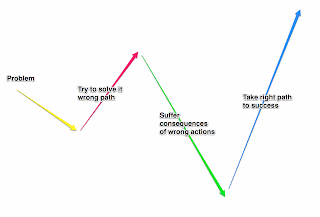In the last blog, we completed our mapping of the steps of our story. But there's still way more surprises and insights to come. I also need to show you whether it fits all my criteria for what I'm looking for in a story theory.
But first, I want to take an even wider view of what we've accomplished to show you an even easier way to look at story structure. There are four parts that we've covered.
• The first part sets up the world and the problem, including the solution to the problem in the form of the ignored lesson.
• The second part shows the character going about it all wrong.
• The third part shows the character suffering the consequences of doing it wrong.
• The last part shows the character after they've learned the lesson and doing it right, and the consequences of doing it right.
Here it is in a simplified chart of the four part story structure.
(CLICK TO ENLARGE)
Now this is very similar to traditional three act structure. You can see the three acts with the middle act break compared here. I never said I was throwing out story theory, only furthering it to make it useful to me and anyone who would like an easier way- one that you can see the big picture. The world if filled with unfinished stories. Let's turn them into good ones.

The key to the turns are the path of the message. It's ignored during the first turn and the character goes about all wrong. Then the consequences hit during the second turn, and finally incorporated during the last turn between hope and fear.

Now let's look at it from an even wider viewpoint. What is the relationship between parts 1 and 4 or Acts 2a and 3? They're OPPOSITES! This is what defines the story. It's the progression from one side of the opposite to the other.
If, for example, the character goes about trying to get what they want by lying, then the story must conclude with them telling the truth. The audience senses this in their gut, and feels fulfills when that happens. It provides closure.
The concept of opposites also allows you to define your other characters in relation to what the main character has to learn. They might also be dealing with the opposites or opposites of the opposites.
I have found that once I have the pair of opposites defined, my story practically writes itself with this structural map. I know exactly where I'm going. I've used it on a number of children's stories in various stages of development. And it works for me.
I hope you can now see why I called my introductory book on the subject, "Iggy's Incredibly Easy Way to Write a Story." More to come...



No comments:
Post a Comment